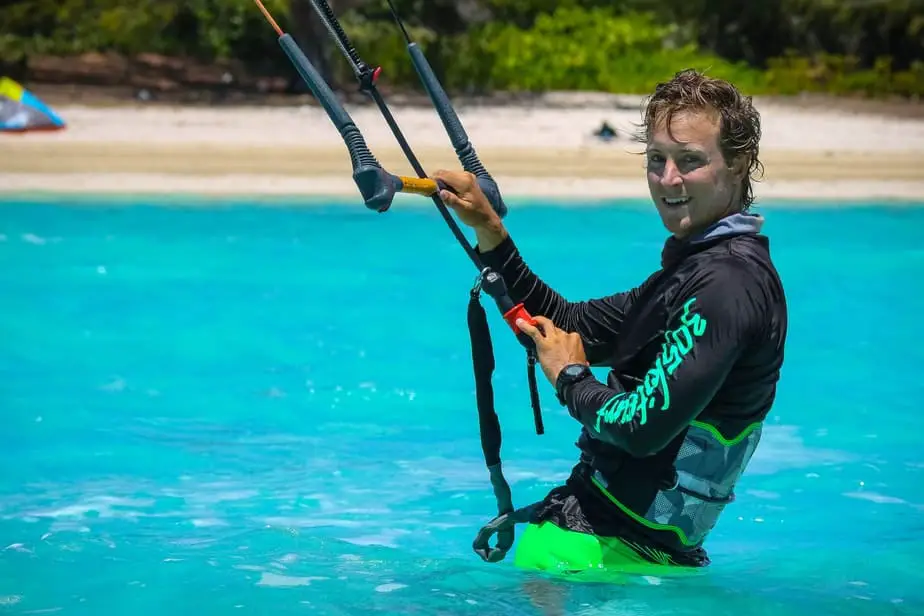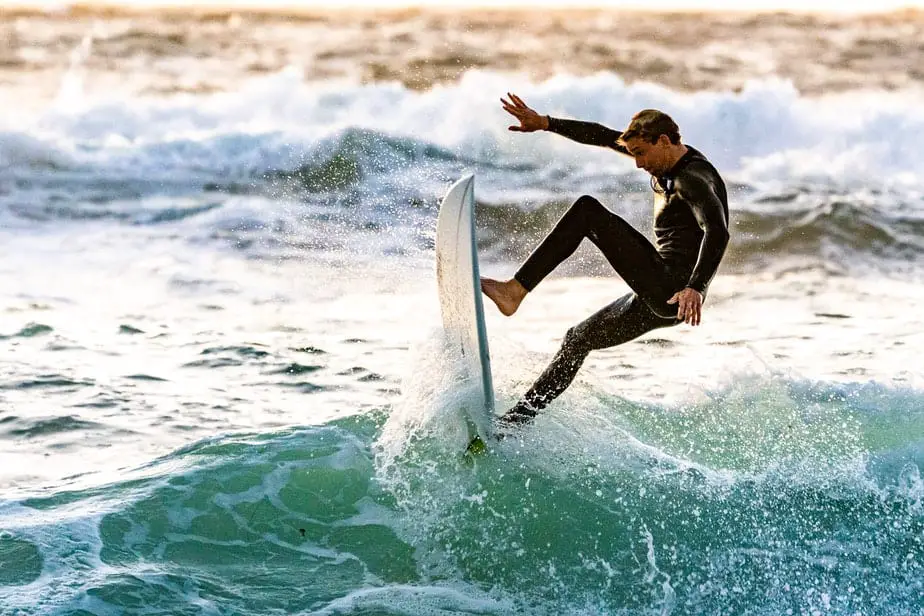Wetsuits and rash guards seem similar at first. Both are protective layers that are designed to be worn in the water, and to the untrained eye, a rash guard may seem like a thinner wetsuit. However, there are some major differences between these two pieces of gear, and this article will go over what separates them
Rash guards are designed to protect your skin against rashes by placing an extra layer between your skin and the board. They are NOT effective at keeping you warm in the water unless worn with a wetsuit. If you want better protection than a rash guard offers and you want to stay warm, then look for a wetsuit instead.
What is a rash guard?
Rash guards, also known as rashies and rash vests, are a type of protective clothing commonly worn by surfers to prevent their torsos from rubbing against the rough surf wax on their boards to prevent getting a rash.
Sun protection
If your wetsuit has a UPF rating, then that means it also pull double-duty as a layer of protection against the sun’s UV rays. On hot days where you’d toast in a wetsuit, a rash guard is a lighter, less restrictive, and just as effective way to protect your skin against sunburns. The more you cover up your skin with UPF clothing, the less reef-safe sunscreen you need to use which is very convenient and cost-efficient.
On cooler days, many people will use their rash vests as a base layer to be worn underneath their wetsuit. This not only keeps you extremely warm, but it can also protect sensitive areas like the neck and underarms from chafing against the wetsuit seals and seams.
Can be worn as a base layer
Though most rashies are not designed to keep you warm (try wearing one on a windy day, you’ll freeze), some of them are made with special material that offers better insulation. For instance, the Rip Curl Flashbomb Polypro uses polypro lining, which is a lightweight, fast-drying fleece material that is proven to be very effective at insulating body heat.
Rashies can be either tight fitting or loose-fitting, depending on your preference. If you think you might wear it under a wetsuit, you need a snug fit so it won’t wrinkle or bunch up when used as a base layer. If you plan on just using it as UV and rash protection, then a loose-fitting one will suffice.
Conversely, sometimes rash vests are used by sailors to improve their performance while dinghy sailing. They’ll wear a loose-fitting one over their buoyancy device and other layers to reduce windage and prevent them from snagging onto other parts of the boat.
Maintenance
When cleaning your rash vest, we recommend doing it by hand in cold water without using any detergents. You do not want to accidentally remove the protective coating on the shirt which would reduce its sun-blocking effectiveness.
Prevents rashes
Is it any surprise that a rash guard can help prevent rashes? It’s even in the name! They are often used by surfers in the summer so that they can protect their skin from rubbing against the surfboard. As mentioned, they can be worn under a wetsuit as a base layer and this can also help reduce wetsuit rashes since the rash guard is preventing the wetsuit from directly rubbing against your skin.
What is a wetsuit?

A wetsuit can do everything a rash guard does, but its most beneficial feature is that it can keep you warm in cold water. Even though rash guards seem like they can offer you some insulation, most don’t and you cannot expect it to be as effective as a wetsuit. Wetsuits can be used like rash guards, but the reverse is NOT true.
Material
When shopping for a wetsuit, especially online, make sure to look for products that are made with neoprene. The neoprene material may also be laminated with nylon, spandex, polyester, or a similar fabric. If the wetsuit is not made with neoprene, it is not effective at keeping you warm.
Neoprene is a water-resistant material that is also flexible and an excellent insulator, making it the ideal material for waterwear. Inside the neoprene are thousands of bubbles that are very effective at insulating your body heat. These bubbles also provide buoyancy, so wetsuits make it easier for you to stay afloat.
Type
Wetsuits come in various styles. There are full-body wetsuits which cover your body except your head, hands, and feet. This obviously offers the most warmth and protection. Then, there are shortie wetsuits which only cover your torso, upper arms, and thighs. They provide more flexibility at the expense of less protection.
Shorties are often worn during the summer because they aren’t as unbearably hot compared to wearing a full wetsuit. Furthermore, the extra mobility improves one’s performance in whatever water activity they are doing, such as surfing or canoeing.
You can find wetsuits with varying thicknesses of the neoprene material. There are thin 1.5mm ones, but the standard wetsuits are 3mm, all the way up to 7mm+ for cold water use. The thicker the wetsuit, the more bubbles in the neoprene that can trap your body heat. Once the water gets too cold, then it’s better to wear a drysuit instead of a wetsuit to stay warm.
Fit
In order for a wetsuit to be effective, it should fit you very snug. This is not to keep the water out, but rather so that your body heat can be more easily trapped by the wetsuit. Some water will enter the wetsuit, but it will get warmed up by the body heat inside, effectively creating a layer of warm water around your body.
When ordering a wetsuit, consider ordering it a size or two too small so that it fits tight, but should not be suffocating or restricting your blood flow. A wetsuit that is too loose will allow water to flush out all of the body heat, defeating the purpose. Wetsuits that are tight at first will stretch out in the water over time so the fit will be more comfortable after you break it in.
Maintenance
Make sure to thoroughly rinse your wetsuit between dives, especially if you’ve peed in it. Read the care instructions that come with your wetsuit. Generally speaking, you should hand wash it and you can use a wetsuit cleaner if it has become particularly dirty. Do not put your wetsuit in the washing machine.
Wetsuit thickness and temperatures to wear them at
| Water Temperature Range | Wetsuit Thickness | Recommended Wetsuit Type | Seal Type |
| >72°F (>22°C) | N/A | Rash guard | N/A |
| 65°- 75°F (18° – 24°C) | 0.5 mm – 2/1 mm | Top / Shorty | N/A |
| 62°- 68°F (16° – 20°C) | 2 mm – 3/2 mm | Springsuit / Full Suit | Flatlock |
| 58°- 63°F (14° – 17°C) | 3/2 mm – 4/3 mm | Full Suit + Boots | Sealed |
| 52°- 58°F (11° – 14°C) | 4/3 mm – 5/4/3 mm | Full Suit + Boots + Gloves + Hood | Sealed and Taped |
| 43°- 52°F (6° – 11°C) | 5/4 mm – 5/4/3 mm | Full Suit + Boots + Gloves + Hood | Sealed and Taped |
| 42°F (6°C) and below | 6/5 mm + | Full Suit + Boots + Gloves + Hood | Sealed and Taped |
Differences between wetsuits and rash guards
The biggest difference between a wetsuit and a rash guard is that a wetsuit will actually keep you warm. The neoprene in the wetsuit is a very effective insulator that will retain your body heat even in cold water. However, this is also its downside: wetsuits have to be a certain thickness in order to be effective at retaining heat, and the thicker a wetsuit is, the harder it is to move around in.
We’ve already mentioned what a rash vest can do for you in the “What is a rash guard” section. Just know that a wetsuit can do everything a rashie can. Whether it is UV protection, rash prevention, even the mobility downside we mentioned above can be alleviated by wearing a shortie.
Should you buy a rash guard or wetsuit?

If we’re debating which one is “better”, we would have to say a wetsuit has more utility since it can do everything a rash guard can and more. However, not everyone wants or needs a wetsuit, so if a rash guard is enough for your needs, then just get that instead.
For example, swimmers, snorkelers and surfers who stay in warm waters may opt for a rash guard since it protects their skin against rashes and the sun’s rays. The UV rays are extremely damaging to the skin because it can cause you to age faster and put you at risk of cancer. Furthermore, sunburns are painful and can easily ruin your tropical island vacation.
With a rashie, you can also make your sunscreen lotion last longer because you don’t need to apply it to areas that will be covered up. Furthermore, even a rash vest can offer some protection against jellyfish stings.
On the other hand, if you want an even higher level of protection than what a rashie can provide, and you plan on heading out into temperate waters, then you need a wetsuit. Because of the wetsuit thickness, you have even more superficial protection, extra buoyancy, and warmth. You can even wear a shortie if you find a full-length wetsuit to be too warm.
Most wetsuits are 3mm thick, but you can find some shorter ones at 1.5mm or 2mm thickness which still provides more protection than a rashie can. Keep in mind, rashies can be worn with a wetsuit. It doesn’t have to be an either or situation. If the water you’ll be surfing, diving, or swimming in is on the colder side, you can wear a rash guard under your wetsuit for an extra layer of warmth.
When it comes to your safety in the water, you cannot be careful enough. You should be prepared with the proper equipment for the activity you will be doing. Do not underestimate what even a flimsy rash guard can do for sun protection. If you will be in warm waters, consider getting a rash guard or a shortie. If you’ll be in cold waters, get a thicker wetsuit and wear a rash guard underneath.

